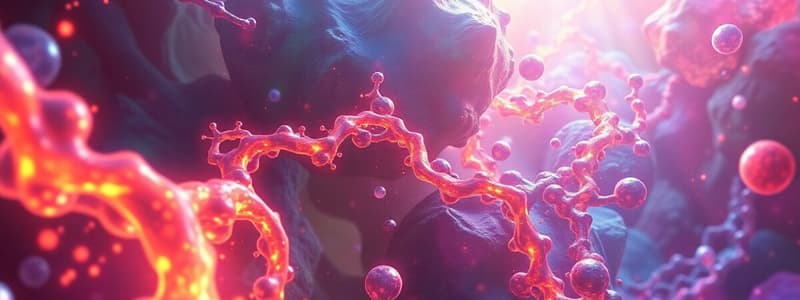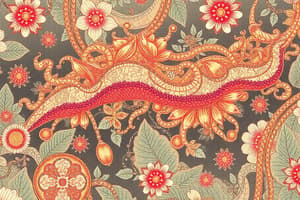Podcast
Questions and Answers
What is the main role of enzymes in biological reactions?
What is the main role of enzymes in biological reactions?
- To change the structure of substrates
- To provide energy for reactions
- To act as catalysts without being consumed (correct)
- To increase the temperature of the reaction
Which classification of enzymes involves the transfer of functional groups?
Which classification of enzymes involves the transfer of functional groups?
- Transferases (correct)
- Isomerases
- Hydrolases
- Lyases
What type of reaction does an oxidoreductase enzyme catalyze?
What type of reaction does an oxidoreductase enzyme catalyze?
- Isomerization
- Hydrolysis
- Ligation
- Redox reactions (correct)
What feature characterizes the active site of an enzyme?
What feature characterizes the active site of an enzyme?
Which of the following is NOT a type of enzyme classification based on reaction type?
Which of the following is NOT a type of enzyme classification based on reaction type?
What is an example of a nonprotein moiety that can participate in enzyme catalysis?
What is an example of a nonprotein moiety that can participate in enzyme catalysis?
Which statement about the efficiency of enzymes is correct?
Which statement about the efficiency of enzymes is correct?
Which type of enzyme is responsible for the hydrolytic cleavage of covalent bonds?
Which type of enzyme is responsible for the hydrolytic cleavage of covalent bonds?
What is the effect of competitive inhibition on Km?
What is the effect of competitive inhibition on Km?
Which statement about Vmax in competitive inhibition is true?
Which statement about Vmax in competitive inhibition is true?
What distinguishes noncompetitive inhibition from competitive inhibition?
What distinguishes noncompetitive inhibition from competitive inhibition?
In a Lineweaver-Burk plot, how do the lines for noncompetitive inhibition appear?
In a Lineweaver-Burk plot, how do the lines for noncompetitive inhibition appear?
Which type of effectors are substrates that function as positive effectors in allosteric enzymes?
Which type of effectors are substrates that function as positive effectors in allosteric enzymes?
What is the effect of noncompetitive inhibition on the apparent Vmax of a reaction?
What is the effect of noncompetitive inhibition on the apparent Vmax of a reaction?
What is an example of a competitive inhibitor mentioned?
What is an example of a competitive inhibitor mentioned?
What characterizes heterotropic effectors in allosteric enzymes?
What characterizes heterotropic effectors in allosteric enzymes?
What characterizes holoenzymes in relation to apoenzymes?
What characterizes holoenzymes in relation to apoenzymes?
Which coenzyme is derived from riboflavin?
Which coenzyme is derived from riboflavin?
How does acid-base catalysis differ between specific and general catalysis?
How does acid-base catalysis differ between specific and general catalysis?
What role do coenzymes play in enzymatic reactions?
What role do coenzymes play in enzymatic reactions?
What is the primary mechanism by which catalysis by strain operates?
What is the primary mechanism by which catalysis by strain operates?
Which of the following metals is classified as a cofactor?
Which of the following metals is classified as a cofactor?
What is the signature characteristic of covalent catalysis in enzymatic reactions?
What is the signature characteristic of covalent catalysis in enzymatic reactions?
In which mechanism is the concentration of substrates directly related to the reaction rate?
In which mechanism is the concentration of substrates directly related to the reaction rate?
What effect does lowering the activation energy have on the rate of a reaction?
What effect does lowering the activation energy have on the rate of a reaction?
Which factor does NOT affect the velocity of enzyme-catalyzed reactions?
Which factor does NOT affect the velocity of enzyme-catalyzed reactions?
At what condition does the reaction velocity become constant and equal to Vmax?
At what condition does the reaction velocity become constant and equal to Vmax?
What is the significance of the Michaelis constant (Km)?
What is the significance of the Michaelis constant (Km)?
What occurs when the temperature exceeds the stability limit of human enzymes?
What occurs when the temperature exceeds the stability limit of human enzymes?
In the context of enzyme kinetics, what does a high Km value indicate?
In the context of enzyme kinetics, what does a high Km value indicate?
What is the result of plotting the reciprocal of reaction velocity (Vo) against substrate concentration ([S])?
What is the result of plotting the reciprocal of reaction velocity (Vo) against substrate concentration ([S])?
In an enzyme-catalyzed reaction, increasing substrate concentration has which effect until Vmax is reached?
In an enzyme-catalyzed reaction, increasing substrate concentration has which effect until Vmax is reached?
Which compound allosterically inhibits phosphofructokinase-1?
Which compound allosterically inhibits phosphofructokinase-1?
Which process is responsible for activating zymogens?
Which process is responsible for activating zymogens?
What is the typical time required for a change in enzyme synthesis or degradation?
What is the typical time required for a change in enzyme synthesis or degradation?
What is the result of product inhibition in enzymatic reactions?
What is the result of product inhibition in enzymatic reactions?
Which enzyme modification typically activates the enzyme?
Which enzyme modification typically activates the enzyme?
What role does insulin play in enzyme regulation?
What role does insulin play in enzyme regulation?
Which of the following is NOT a mechanism of enzyme regulation?
Which of the following is NOT a mechanism of enzyme regulation?
How does allosteric control affect enzyme activity?
How does allosteric control affect enzyme activity?
Study Notes
Enzyme Activity
- High activation energy (Eact) in uncatalyzed reactions results in slow reaction rates.
- Lower activation energy leads to faster reaction rates.
- Enzymes provide an alternative reaction pathway that lowers activation energy and does not affect the free energy of substrates and products.
Factors Affecting Reaction Velocity
- Substrate concentration: The rate of an enzyme-catalyzed reaction increases with substrate concentration until a maximal velocity (Vmax) is reached.
- Temperature: Increasing temperature increases the rate of both uncatalyzed and enzyme-catalyzed reactions by increasing kinetic energy and the collision frequency of reacting molecules.
- Higher temperatures can lead to denaturation and loss of catalytic activity.
- Human enzymes generally exhibit stability up to 45-55℃.
- pH: Most intracellular enzymes exhibit optimal activity at pH values between 5-9.
- Extremes of pH can lead to enzyme denaturation.
Michaelis-Menten Kinetics
- Michaelis-Menten Equation:
- Vo = initial reaction velocity
- Vmax = maximal velocity = kcat [E]total
- Km = Michaelis constant = (k-1 + k2)/k1
- [S] = substrate concentration
- Assumptions:
- Substrate concentration is greater than enzyme concentration.
- Concentration of the ES complex does not change with time (steady-state assumption).
- Initial reaction velocities are used in the analysis of enzyme reactions.
- Km:
- Represents the substrate concentration at which the reaction velocity is equal to ½ Vmax.
- Does not vary with enzyme concentration.
- High Km indicates low affinity.
- Low Km indicates high affinity.
Enzyme Classification by Reaction Type
- Oxidoreductases: Catalyze redox reactions.
- Transferases: Transfer moieties such as glycosyl, methyl, or phosphoryl groups.
- Hydrolases: Catalyze the hydrolytic cleavage of C—C, C—O, C—N, and other covalent bonds.
- Lyases (synthases): Catalyze cleavage of covalent bonds by atom elimination, generating double bonds.
- Isomerases: Catalyze geometric or structural changes within a molecule.
- Ligases (synthetases): Join together (ligation) of two molecules in reactions coupled to the hydrolysis of ATP.
Enzyme Structure and Function
- Active Site: Site where catalysis occurs.
- Formed by the folding of proteins.
- Participates in substrate binding and catalysis.
- Nonprotein Moieties: Participate in catalysis.
- Prosthetic groups: Tightly and stably incorporated into a protein's structure by covalent bonds or noncovalent forces.
- Eg. Pyridoxal phosphate, flavin mononucleotide (FMN), flavin adenine dinucleotide (FAD), thiamine pyrophosphate, lipoic acid, biotin, transition metals – Fe, Co, Cu, Mg, Mn, Zn.
- Cofactors: Similar to prosthetic groups, but bind weakly and transiently to their cognate enzymes or substrates.
- Coenzymes: Small organic molecules derived from water-soluble B vitamins.
- Eg. NAD and NADP – nicotinamide, FMN and FAD – riboflavin, Coenzyme A – pantothenic acid.
- Prosthetic groups: Tightly and stably incorporated into a protein's structure by covalent bonds or noncovalent forces.
- Holoenzyme: An active enzyme with its nonprotein moiety.
- Apoenzyme: An enzyme without its nonprotein moiety.
Mechanism of Enzyme Action
- Enzyme binds substrate at the active/catalytic site.
- Active site fits the shape of the substrate.
- Association between enzyme and substrate is temporary.
Four Mechanistic Strategies During Catalysis
- Catalysis by proximity: Increases the frequency of substrate encounters.
- Acid-base catalysis: Ionizable functional groups of aminoacyl side chains act as acids or bases.
- Specific acid or base catalysis: Participating acids or bases are protons or hydroxide ions.
- General acid or base catalysis: Reactions responsive to all acids or bases present.
- Catalysis by strain: Creates a conformational change in an enzyme that weakens bonds.
- Transition state intermediate: A strained conformation midway in the transformation of substrates to products.
- Covalent catalysis: Formation of a covalent bond between enzymes and one or more substrates.
- Ping pong mechanism: First substrate is bound and its product is released prior to the bonding of the second substrate.
Enzyme Inhibitors
- Substances that decrease the velocity of an enzyme-catalyzed reaction.
- Reversible inhibitors: Noncovalent bonds.
- Irreversible inhibitors: Covalent bonds.
- Competitive inhibition: Inhibitor binds reversibly to the same site that the substrate would normally occupy.
- Effect on Vmax: Unchanged.
- Effect on Km: Increases Km.
- Effect on Lineweaver-Burk plot: Inhibited and uninhibited reactions intersect on the y-axis at 1/Vmax and have different x-intercepts at -1/Km.
- Noncompetitive inhibition: Inhibitor and substrate bind at different sites on the enzyme.
- Inhibitor can bind either free enzyme or the enzyme-substrate complex.
- Effect on Vmax: Decreases apparent Vmax.
- Effect on Km: Unchanged Km.
- Effect on Lineweaver-Burk plot: Unchanged Km, decreased apparent Vmax.
Allosteric Enzymes
- Effectors: Bind noncovalently at a site other than the active site (allosteric site).
- Negative effectors: Inhibitors.
- Positive effectors: Increase enzyme activity.
- Homotropic effectors:
- Substrates as effectors.
- Function as positive effectors.
- Sigmoidal curve.
- Positive cooperativity.
- Eg. Hemoglobin.
- Heterotropic effectors:
- Effectors different from substrate.
- Exemplified by feedback inhibition.
- Eg. Phosphofructokinase-1 is allosterically inhibited by citrate (not a substrate).
Covalent Modification
- Phosphorylation and dephosphorylation:
- Phosphorylation: Protein kinases use ATP as a phosphate donor, activating the enzyme.
- Dephosphorylation: Phosphoprotein phosphatase deactivates the enzyme.
- Activation of zymogens:
- Activation via proteolytic action of enteropeptidase (enterokinase) of trypsinogen → trypsin.
- Trypsin catalyzes the subsequent conversion of numerous other pancreatic zymogens.
Enzyme Synthesis
- Cells can regulate the amount of enzyme present by altering the rate of enzyme synthesis.
- Increase or decrease of enzyme synthesis leads to alteration in the total population of active sites.
- Eg. Insulin production in response to hyperglycemia – induction of enzymes involved in glucose metabolism.
Mechanisms of Enzyme Regulation
- Regulation Event: Typical Effector, Results, Time Required for Change
- Substrate availability: Substrate - Change in velocity - Immediate
- Product inhibition: Reaction product - Change in Vmax and/or Km - Immediate
- Allosteric control: Pathway end product - Change in Vmax and/or K0.5 - Immediate
- Covalent modification: Another enzyme - Change in Vmax ad/or Km - Immediate to minutes
- Synthesis or degradation of enzyme: Hormone or metabolite - Change in the amount of enzyme - Hours to days
Studying That Suits You
Use AI to generate personalized quizzes and flashcards to suit your learning preferences.
Related Documents
Description
Explore the fundamental concepts of enzyme activity and the factors affecting reaction rates in this quiz. Learn how activation energy, substrate concentration, temperature, and pH influence enzyme-catalyzed reactions. Test your knowledge of how enzymes operate and their importance in biological processes.




